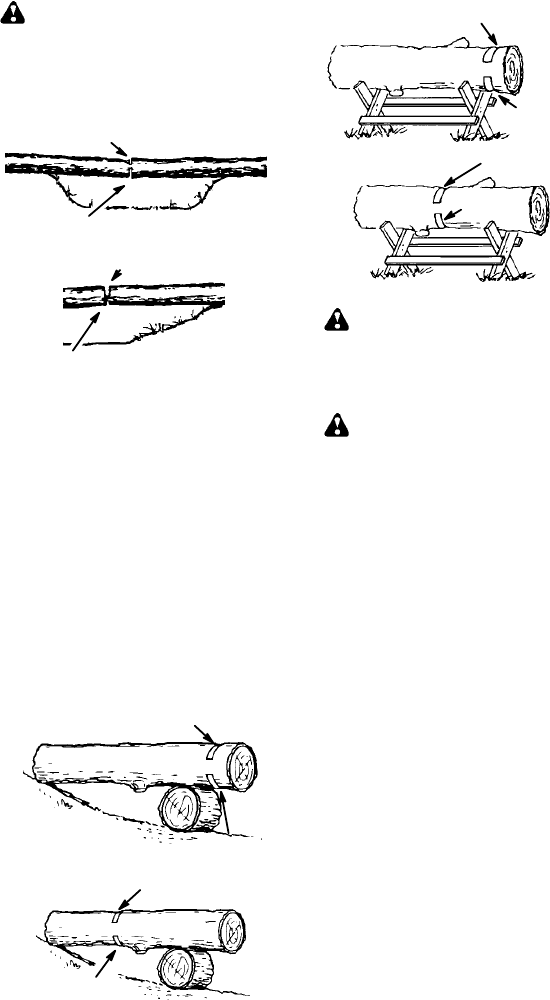
13
WARNING: Neverturnsaw upside
down t o undercut. The saw cannot be con-
trolled in this po sition.
Always make your first cut on thecompres-
sionsideofthelog. Thecompressionsideof
the log is where the pressure of the log’s
weight is concentrated.
Second cut
First cut on compression side of log
First cut on compression side of log
Second cut
BUCKING WITHOUT A SUPPORT
S Overcut t hrough 1/3 of the diameter of the
log.
S Roll the log over and f inish with a second
overcut.
S Watch for logs with a compression side to
prevent the saw from pinching. See il-
lustrations forcuttinglogs withacompres-
sion side.
BUCKING USING A LOG OR
SUPPORT STAND
S Remember your first cut is always on the
compression side of the log.
(Refer to the illustrations below for your
first and second cut)
S Your first cut should extend
1/3 of the
diameter of the log.
S Finish with your second cut.
1
st
Cut
2
nd
Cut
Usingalogforsupport
2
nd
Cut
1
st
Cut
1
st
Cut
2
nd
Cut
Using a support stand
1
st
Cut
2
nd
Cut
LIMBING AND PRUNING
WARNING: Be alert for and guard
against kickback. Do not allow the moving
chain to contact any other branches or objects
at the nose of the guide bar when limbing or
pruning. Allowing such contact can result in
serious i n jury .
WARNING: Neverclimbintoa treeto
limb or prune. Do not stand on l adders, plat-
forms,alog,orinany positionwhichcancause
you to lose your balance or control of thesaw .
IMPORTANT POINTS
S Work slowly, keeping both hands firmly
gripped on the saw. Maintain secure f ooting
and bala nce.
S Watch out for springpoles. Springpoles are
small size limbs which can catch the saw
chain andwhip to wardyouorpullyouoffbal-
ance. Use e xtreme caution when cutting
small size limbs or slender material.
S Be alert for springback. Watch out for
branches that ar e bentor under pr essure.
Avoid being struck by the branch or the
saw whenthe tensionin thewood fibers is
released.
S Keep a clear work area. Frequently clear
branches out of the way to avoid tripping
over them.
LIMBI NG
S Alwayslimbatreeafteritis cutdown. Only
then can limbingbe donesafely and prop-
erly.
S Leave the larger limbs und erneath the felled
tree t o support t he tr ee as you work.
S Start a t the base of the felled tree and work
toward t he top, cutting b ranches and limbs.
Remove small limbs with one cut.
S Keep the tree between you and the chain.
Cut from the side of the tree opposite the
br a n ch you ar e cut t i n g .
S Remove la rger , supporting br anches with
the cutting techniques described in BUCK-
ING W ITHOUT A SUPPOR T.
S Always use an o vercut to cutsmall andfree-
ly hanging limbs. Undercutting could cause
limbs to fall and pinch the saw .


















